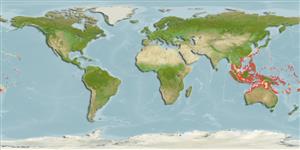>
Ovalentaria/misc (Various families in series Ovalentaria) >
Pomacentridae (Damselfishes) > Pomacentrinae
Etymology: Amphiprion: Greek, amphi = on both sides + Greek, prion, -onos = saw (Ref. 45335).
More on author: Bleeker.
Environment: milieu / climate zone / depth range / distribution range
Ecologia
marinhas; estuarina associadas(os) a recifes; não migratória; intervalo de profundidade 1 - 38 m (Ref. 86942). Tropical; 34°N - 22°S, 96°E - 156°E (Ref. 55269)
Western Pacific: Gulf of Thailand and Cocos-Keeling in the eastern Indian Ocean to Samoa and Tonga (Ref. 53797), north to the Ryukyu Islands, south to the Great Barrier Reef, and New Caledonia.
Comprimento de primeira maturação / Tamanho / Peso / Idade
Maturity: Lm ?, range 6 - ? cm
Max length : 10.0 cm TL macho/indeterminado; (Ref. 9710)
Espinhos dorsais (total): 9 - 10; Raios dorsais (total): 16-17; Espinhos anais 2; Raios anais : 12 - 13.
Adults inhabit lagoon and seaward reefs (Ref. 1602). Mainly diurnal. Non-burrowing. Monogamous (Ref. 52884). A protandrous hermaphrodite (Ref. 32166). Oviparous, distinct pairing during breeding (Ref. 205). Eggs are demersal and adhere to the substrate (Ref. 205). Males guard and aerate the eggs (Ref. 205). Associated with the anemones: Heteractis magnifica (usually), Heteractis crispa, Macrodactyla doreensis, Stichodactyla gigantea (Ref. 5911). In Bali they occur together with the closely related Indian Ocean species A. akallopison and have even been found sharing the same anemone (Ref. 48636). Has been reared in captivity (Ref. 35413, 35418, 35420).
Oviparous, distinct pairing during breeding (Ref. 205). Monogamous mating is observed as both obligate and social (Ref. 52884). Eggs are demersal and adhere to the substrate (Ref. 205). Males guard and aerate the eggs (Ref. 205). One pair spawns several times per year. Annual fecundity is estimated to be 2,000 to 4,000 eggs. Size at sex change = 5.4 cm TL (Ref. 55367). Also Ref. 240, 7471.
Allen, G.R., 1991. Damselfishes of the world. Mergus Publishers, Melle, Germany. 271 p. (Ref. 7247)
Status na Lista Vermelha da UICN (Ref. 130435)
Ameaça para os humanos
Harmless
Uso pelos humanos
Pescarias: sem interesse; Aquário: Espécies comerciais
Mais informação
ReferênciasAquaculturaPerfil para aquaculturaEstirpesGenéticaElectrophoresesHereditariedadeDoençasProcessamentoNutrientsConversão de massa
Ferramentas
Relatórios especiais
Baixar XML
Fontes da internet
Estimates based on models
Preferred temperature (Ref.
123201): 25.2 - 29, mean 28 °C (based on 668 cells).
Índice de diversidade filogenética (Ref.
82804): PD
50 = 0.5000 [Uniqueness, from 0.5 = low to 2.0 = high].
Bayesian length-weight: a=0.02344 (0.01149 - 0.04783), b=2.99 (2.82 - 3.16), in cm total length, based on LWR estimates for this (Sub)family-body shape (Ref.
93245).
Nível Trófico (Ref.
69278): 2.2 ±0.0 se; based on diet studies.
Generation time: 2.3 ( na - na) years. Estimated as median ln(3)/K based on 1
growth studies.
Resiliência (Ref.
120179): médio(a), tempo mínimo de duplicação da população 1,4 - 4,4 anos (K=0.48; tm=1.75-1.83; annual Fec=2,000-4,000).
Fishing Vulnerability (Ref.
59153): Low to moderate vulnerability (26 of 100).
Nutrients (Ref.
124155): Calcium = 111 [49, 178] mg/100g; Iron = 0.729 [0.430, 1.319] mg/100g; Protein = 18.1 [16.9, 19.3] %; Omega3 = 0.121 [0.068, 0.207] g/100g; Selenium = 23.3 [11.3, 48.4] μg/100g; VitaminA = 94.4 [22.7, 361.4] μg/100g; Zinc = 2.33 [1.52, 3.68] mg/100g (wet weight);
